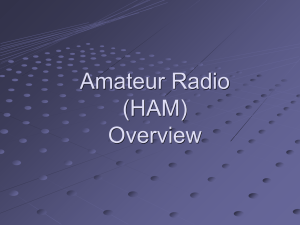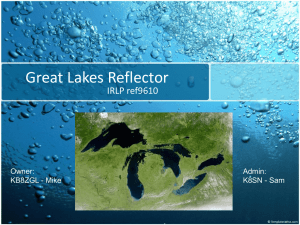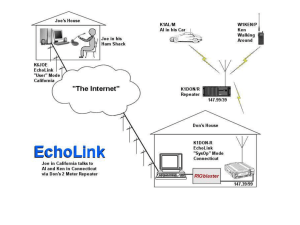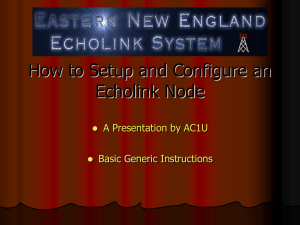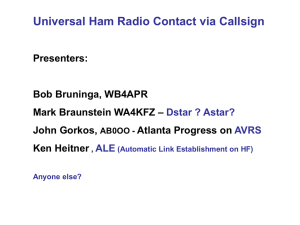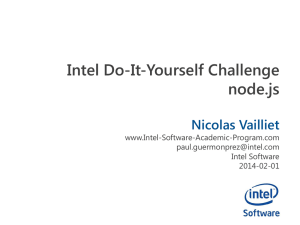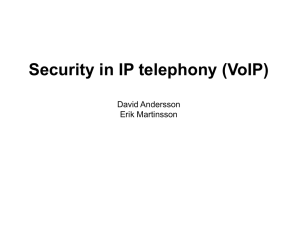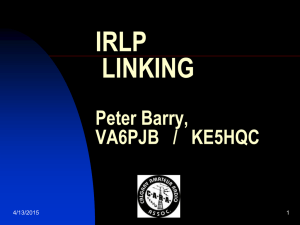Inside Echolink
advertisement
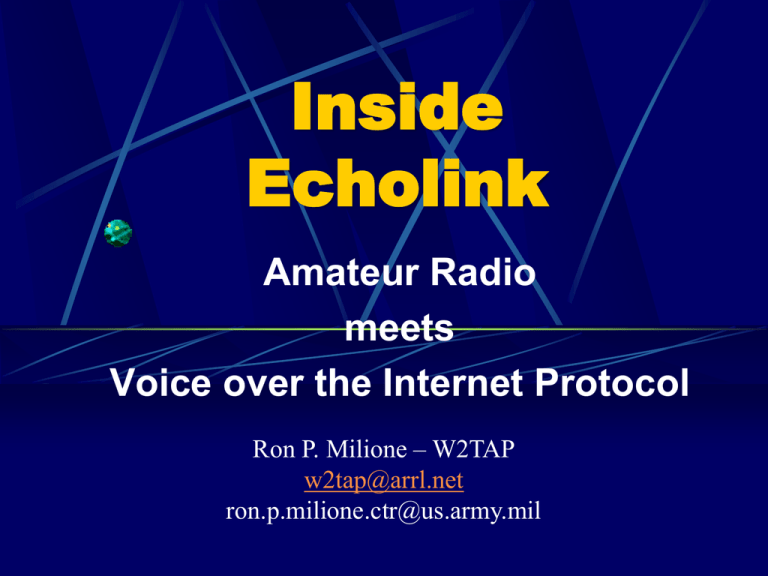
Inside Echolink Amateur Radio meets Voice over the Internet Protocol Ron P. Milione – W2TAP w2tap@arrl.net ron.p.milione.ctr@us.army.mil Overview VoIP Concepts and Terminology Analog, Digital, Samples, Buffers Packets, Client/Server, TCP/IP Ham VoIP Projects Access, Modes, Connecting, Audio Quality Topology, Users, Is this ‘Ham Radio’? EchoLink Software Graphical User Interface Setup, Radio, Computer Modes, Configuration Radio Interfaces W2LV - Live Node Demo Good Practices Common Problems What is VoIP? Convert Voice to Digital 1’ 0’s (A/D) Compress Digital Data (Encode) Buffer digital sample data into packets Send packet buffers via Internet Protocol Receive and assemble packet buffers Uncompress Digital Data (Decode) Convert Digital 1’s 0’s to Voice (D/A) What is THIS Echolink? EchoLink uses VoIP (Voice Over Internet Protocol) to allow licensed Amateur Radio Operators to communicate with other Amateurs via the Internet. It is primarily a Windows based application and is offered free of charge at http://www.echolink.org. There is also a new EchoLinux and EchoMac available. It was developed by Jonathan Taylor (K1RFD) in 2002 (He received Hamvention 2003 Special Achievement Award). A/D – D/A Terms and Concepts Analog <> Digital Continuous <> Discrete Air Pressure <> Volts Sampling Rate Freq. (KHz) 8, 11, 22, 44 Unit time (secs) Sampling Bits Quantization (#) 2^8, 2^16 Dynamic range (dB) 50, 98 Nyquist Theorem Sample Rate >= 2 x Freq. Encode / Decode Compress / Decompress Codec Types GSM (E/L 8kbps) uLaw aLaw ADPCM Function Don’t send dead air Combined similar values Save space and time What Modes Are Available? EchoLink can be operated strictly between two computers connected to the Internet using the PC soundcard with Speakers and a Microphone. EchoLink can be interfaced to a standard FM transceiver as a “simplex link” from your home QTH. EchoLink can be interfaced to a VHF or UHF repeater for more coverage. Internet and IP Hosts Routers Dotted Decimal Addresses Transport (TCP/UDP) Source & Destination Ports Data / Buffers Checksum Connecting via VoIP Two methods / implementations Client / Server (Middleman) Client is Authenticated (Callsign / Password) Client Requests Users List ( Callsign, IP Addr.) Client Makes Connection to User No Central Server (Client to Client) Client Must manually obtain remote IP Addr. Client Makes Connection to User Amateur Radio VoIP Projects EchoLink – http://www.echolink.org/ IRLP – http://www.irlp.net/ CQiNet – http://cqinet.sourceforge.net/ WIRES II – http://www.vxstd.com eQSO – http://www.eqso.net/ Echolink Overview Link Radio Amateurs via the Internet PC-PC Users, PC-RF Gateways, RF-RF Simple Password Access to Server “By Hand” Callsign check for Password Validation GSM Vocoder 8kbps/user Lower Voice Quality (Dial-up or Broadband ISP) Multiple Connections per Node Possible Bandwidth Limited (Broadband Required for Conf) Node Information (http://www.echolink.org/logins.asp) 4715+ Active Nodes Worldwide 1050 Users, 1464 Links, 1113 Repeaters, 192 Confs. VoIP Network Topology 209.176.50.1 68.54.3.2 W2TAP 128.10.60.73 WA2CDL 212.50.33.5 141.9.5.102 W2LV W4AJX PC to PC Sys Op Mode Simplex Link Repeater Link PC Users, Links, Repeaters EchoLink - The Software Windows Mac Linux Sysop User And now -- The Software… Here is the main Screen, listing the Stations currently on the Link, by Country, Call Zone etc. The Bottom of the Screen shows the current Transmit and Receive Audio levels in a colored bar graphic. Basic Setup The first thing to do after installing the software is to configure your Station Setup. The first time you use Echolink, you will have to wait to be validated, before you are connected to the EchoLink server. Audio Setup This includes your Audio details, for the PC Speakers and Microphone. Connection Setup This Screen allows you to configure the various Internet connections you are willing to accept. The Two Pc Audio Screens This is the Output This is the Input Interfaces Types Commercial Homegrown Function Isolate Attenuate Match Key PTT COR Commercial Interfaces DIY Interface Schematic W2VL Echolink node #487981 Call Node Location/Connection Status W2VL-R 487981 LIMARC, GlenOaks, NY (1) ON 40.7470463 -73.7115199 146.850MHz (-) Offset Duplex Supports 4+ simultaneous users Access is Open 24/7 IRLP ID: 4438 W2KPQ Echolink node #503075 Call Node Location/Connection Status W2KPQ-R 487981 LIMARC, SELDEN, NY (1) ON 40.8664873 -73.0356625 147.3750MHz (+ offset) Duplex Supports 4+ simultaneous users Access is Open 24/7 IRLP ID: 4478 Control Operation 3 Levels of Control DTMF over Link Frequency HTTP Web Interface Direct PC Keyboard Control Operators LIMARC WA2CDL - Andy Node DTMF Commands Given as an example Status – 08 Connect – 4, 5, 6 digit node number Echo Test Server = 9999 short cuts, ex: *90 = WA2CDL-R Disconnect - # Reconnect – 09 Help File -*411 Good Operating Practices Identify Yourself When connecting When sending DTMF Pause, Wait, Listen Use DTMF Status Command 08 Rag chewers beware 3 minute timeout Common Problems Connection Timeout Disconnects Audio issues Broken Garbled Drop outs W2VL REPEATER W2KPQ REPEATER Local EchoLink Nodes List Local EchoLink Nodes Map Question? Tnx & 73 ! Ron Milione Ph.D. w2tap@arrl.net ron.p.milione.ctr@us.army.mil
